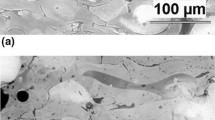Abstract
Examples are given of the use of nanodispersed forms of silica in making refractory and high-porosity (thermal insulation) materials. There is a discussion of the use of finely divided silica materials and wet grinding in the technologies of glass and glass ceramics. Conditions are formulated for wet grinding to reduce the grain size of hydrating materials. Prospects are considered for using technologies based on finely divided silica in making many silicate and oxide materials.
Similar content being viewed by others
References
M. R. Ismael, “Optimization of the particle size distribution of colloidal silica containing refractory castables” (M. R. Ismael, R. Salomao, and V. C. Pandofelli), Interceram. Refractories Manual (2007), pp. 34–39.
L. A. Angolenko, “Properties of materials in the Al2O3-SiC-C system after firing in a reducing medium” (L. A. Angolenko, G. D. Semchenko, S. V. Tishchenko, et al.), Novye Ogneupory, No. 10, 52–56 (2007).
S. Goberis, “Effects of the amount of microsilica on the rheology of a cement paste and characteristics of low-cement heat-resisting concrete containing a firebrick filler” (S. Goberis, V. Antonovich, I. Pundene, et al.), Novye Ogneupory, No. 5, 41–46 (2007).
O. V. Tomchani, “Nanostructural heat insulating materials” (O. V. Tomchani, G. R. Arutyunyan, V. P. Pavlova, et al.), Collection of Abstracts on the Construction and Technology for Making Components of Nonmetallic Materials [in Russian], Obninsk (2007), pp. 90–92.
E. Ya. Litovskii, “Temperature dependence of the thermal conductivity and thermal diffusivity of unfired quartz ceramic” (E. Ya. Litovskii, Yu. E. Pivinskii, T. I. Litovskaya, et al.), Izv. AN SSSR, Neorganicheskie Materialy, 26, No. 12, 2615–2618 (1990).
Yu. E. Pivinskii, “Preparation and properties of finely divided foam concretes based on finely divided suspensions of quartz sand” (Yu. E. Pivinskii, T. N. Epifanova, and N. A. Peretokina), Ogneupory i Tekhnicheskaya Keramika, No. 10, 6–10 (1998).
N. A. Peretokina, Technology of Cellular Ceramoconcrete Based on Composite Bonding Agents: MsC Thesis [in Russian], Belgorod (2007).
N. M. Pavlushkin (editor), Chemical Technology of Glass and Glass Ceramics [in Russian], Stroiizdat, Moscow (1983).
V. F. Solinov, “New concepts on glass forming processes,” in: V. F. Solinov, Proceedings of the International Conference on the Science and Technology of Silicate Materials: Present and Future. Volume 1, Plenary Reports [in Russian], KhTU im. D. I. Mendeleeva (2003), pp. 134–143.
E. I. Suzdal’tsev, “Making high-density aqueous suspensions and forming blanks from lithium-aluminum silicate glass,” Ogneupory i Tekhnicheskaya Keramika, No. 11, 10–23 (2002).
E. I. Suzdal’tsev, “Effects of heat treatment conditions on the structure formation and properties of glass and glass ceramics of lithium-aluminum silicate composition,” Ogneupory i Tekhnicheskaya Keramika, No. 4, 16–25 (2002).
E. I. Suzdal’tsev, Synthesis of High-Temperature Stable and Radio-Transparent Glass-Ceramic Materials and Development of the Technology for Making Them in the Form of Fairing for Aircraft: PhD Thesis [in Russian], Moscow (2002).
S. V. Shestoperov, Concrete Technology [in Russian], Vysshaya Shkola, Moscow (1977).
V. I. Solomatov, Intensive Concrete Technology (V. I. Solomatov, M. K. Takhirov, and M. T. Shakh) [in Russian], Stroiizdat, Moscow (1989).
H. Taylor, The Chemistry of Cement (Russian translation from English by A. I. Baikova and T. V. Kuznetsova), Mir, Moscow (1996).
B. Verinski, “Effects on the properties of cement from the grain-size composition,” Sixth International Congress on Cement Chemistry. Volume 2, Cement Hydration and Hardening, Book 1 [in Russian], Stroiizdat, Moscow (1976), pp. 176–179.
G. S. Krykhtin, “Hydration rate and grain size in cements” (G. S. Krykhtin and V. I. Zhrako), Ibid., pp. 179–182.
Yu. V. Khomchenko, “Mechanoactivation of materials for autoclave hardening” (Yu. V. Khomchenko and V. D. Barbanyagre), Vestnik BGTU, No. 10, 317–322 (2005).
Yu. V. Khomchenko, “Mechanoactivation of lime-silica suspensions for pressed autoclave materials” (Yu. V. Khomchenko and V. D. Barbanyagre), Izv. OrelGTU, Stroitel’stvo, Transport, No. 1–13 (529), 51–54 (2007).
Yu. V. Khomchenko, Intensifying the Solidification of Pressed Autoclave Materials Based on Ground Lime-Sand Plaster in the Form of a Concentrated Suspension: MSc Thesis [in Russian], Belgorod (2007).
Yu. E. Pivinskii, “Studies on the rheological and bonding properties of aqueous suspensions of quartz sand,” Ogneupory, No. 6, 39–45 (1980).
Yu. E. Pivinskii, “Preparation and properties of some silica ceramoconcretes,” Stroit. Materialy, No. 4, 14–18 (1993).
M. A. Trubitsyn, “Production of unfired building materials based on silica suspensions” (M. A. Trubitsyn, I. I. Nemets, Yu. I. Aleshin, et al.), Stroit. Materialy, No. 1, 5–7 (1993).
A. V. Cherevatova, “A multilayer building material based on high-density aqueous suspensions of silica-bearing raw material” (A. V. Cherevatova and E. O. Gashchenko), Stroit. Materialy, No. 4, 22–23 (2006).
E. O. Gashchenko, “Strengthening unfired materials by chemical activation of the contact links” (E. O. Gashchenko, A. V. Cherevatova, and N. V. Pavlenko), Stroit. Materialy, No. 8, 32–33 (2007).
A. V. Cherevatova, “Theoretical principles for designing building composites with the use of highly concentrated bonding systems,” Stroit. Materialy, No. 8, 29–31 (2007).
A. V. Cherevatova, Building Composites Based on Highly Concentrated Bonding Systems: PhD Thesis [in Russian], Belgorod (2007).
E. O. Gashchenko, Cement-Free Building Materials Based on High-Density Aqueous Suspensions: MSc Thesis [in Russian], Belgorod (2007).
E. M. Grishpun, “Twenty-five years of collaboration” (E. M. Grishpun and Yu. E. Pivinskii), Ogneupory, No. 1, 15–25 (2007).
Yu. E. Pivinskii, “Principles of ceramoconcrete technology,” Ogneupory, No. 2, 34–42 (1978).
N. P. Lyakishev, “Energy aspects of steel production” (N. P. Lyakishev and A. V. Nikolaev), Stal’, No. 3, 66–73 (2002).
Author information
Authors and Affiliations
Additional information
__________
Translated from Novye Ogneupory, No. 2, pp. 45–55, February, 2008.
End. Parts 1–3 were published in Nos. 11 and 12 for 2007 and No. 1 for 2008.
Rights and permissions
About this article
Cite this article
Pivinskii, Y.E. Nanodispersed silica and some aspects of nanotechnology in the field of silicate materials science. Part 4. Refract Ind Ceram 49, 67–74 (2008). https://doi.org/10.1007/s11148-008-9018-2
Received:
Published:
Issue Date:
DOI: https://doi.org/10.1007/s11148-008-9018-2




